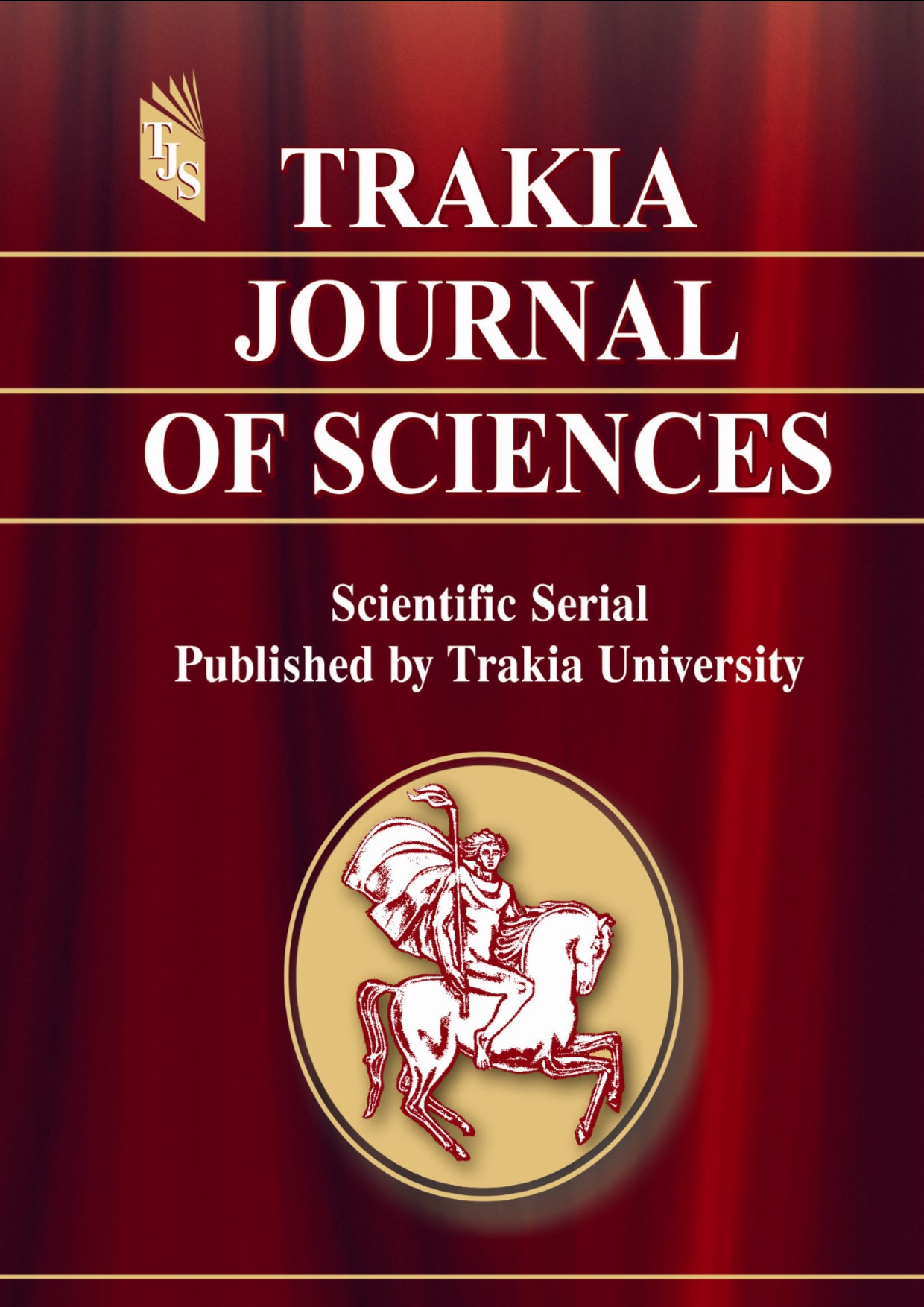SNAKE VENOMS AND THEIR THERAPEUTIC POTENTIAL
DOI:
https://doi.org/10.15547/tjs.2024.03.009Keywords:
Snake venoms, enzymes, neurotoxins, therapeutic applications, drugsAbstract
Snake venoms are complex heterogeneous mixtures containing different bioactive molecules with multivalent nature. Most of these components are proteins displaying enzymatic or non-enzymatic biological and pharmacological activities and toxicological potential. Their functional activities on various tissues and organs lead to the manifestation of diverse effects such as neurotoxicity, myotoxicity, cytotoxicity, inflammation, influence on hemostasis, apoptosis, necrosis and other, causing simultaneous damage to various physiological systems. At the same time, the unique molecular features of snake venom compounds make them valuable scientific tools for understanding different physiological processes, and allows them to fulfil their great potential in medicine and pharmacology as therapeutic agents and diagnostic tools. Many snake venom toxins have been found to exert analgesic, antiplatelet, hypotensive, antitumor, anti/pro-inflammatory or other potencies, as some of them have already been used as a base for design of commercially available pharmaceuticals.
References
Tasoulis, T. and Isbister G., A Review and Database of Snake Venom Proteomes. Toxins, 9:290, 2017.
Tasoulis, T., Pukala, T. and Isbister, G., Investigating Toxin Diversity and Abundance in Snake Venom Proteomes. Front Pharmacol, 12:768015, 2022.
Casewell, N. R., Jackson, T. N. W., Laustsen, A. H. and Sunagar, K., Causes and consequences of snake venom variation. Trends Pharmacol Sci, 41:570–581, 2020.
Kini, R. M., Excitement ahead: structure, function and mechanism of snake venom phospholipase A2 enzymes. Toxicon, 42:827–840, 2003.
Dutertre, S., Nicke, A. and Tsetlin, V., Nicotinic acetylcholine receptor inhibitors derived from snake and snail venoms. Neuropharmacology, 127:196-223, 2017.
Robinson, S., Undheim, E., Ueberheide, B. and King, G., Venom peptides as therapeutics: advances, challenges and the future of venom-peptide discovery. Expert Rev Proteomics, 14:931–939, 2017.
King, G., Venoms as a platform for human drugs: Translating toxins into therapeutics. Expert Opin. Biol. Ther, 11:1469–1484, 2011.
Koh, D., Armugam, A. and Jeyaseelan, K., Snake venom components and their applications in biomedicine. Cell Mol Life Sci, 63:3030-41, 2006.
Staessen, J., Fagard, R., Lijnen, P. and Amery, A., Captopril in the treatment of hypertension. Acta Clin Belg, 37(3):164-84, 1982.
Burke, J. and Dennis, E., Phospholipase A2 structure ⁄function, mechanism, and signaling. J Lipid Res, 50 (Suppl): S237–242, 2009.
Six, D. and Dennis, E., The expanding superfamily of phospholipase A(2) enzymes: classification and characterization. Biochim Biophys Acta, 1488:1-19, 2000.
Georgieva. D., Arni, R. and Betzel, C., Proteome analysis of snake venom toxins: pharmacological insights. Expert Rev Proteomics, 5 (6):787-97, 2008.
Burke, J. and Dennis, E., Phospholipase A2 Biochemistry. Cardiovasc Drugs Ther, 23:49–59, 2009.
Kini, R. and Evans, H., A model to explain the pharmacological effects of snake venom phospholipases A2. Toxicon, 27(6):613-35, 1989.
Gutiérrez, J. and Lomonte, B., Phospholipases A2: unveiling the secrets of a functionally versatile group of snake venom toxins. Toxicon, 62:27–39, 2013.
Menaldo, D., Bernardes, C., Pereira, J., Silveira, D., Mamede, C., Stanziola, L., Oliveira, F., Pereira-Crott, L., Faccioli, L. and Sampaio, S., Effects of two serine proteases from Bothrops pirajai snake venom on the complement system and the inflammatory response. Int. Immunopharmacol, 15:764–771, 2013.
Serrano, S., The long road of research on snake venom serine proteinases. Toxicon, 62:19–26, 2013.
Serrano, S. and Maroun, R., Snake venom serine proteinases: Sequence homology vs. substrate specificity, a paradox to be solved. Toxicon, 45:1115–1132, 2005.
Huang, D., Gai, L., Wang, S., Li, T., Yang, T., Zhi, G., Du, L. and Li, L., Defibrase, a purified fibrinolytic protease from snake venom in acute myocardial infarction. Acta Cardiol, 47(5):445-58, 1992.
Ancrod for the treatment of acute ischemic brain infarction. The ancrod stroke study investigators. Stroke, 25:1755–1759, 1994. doi:10.1161/01.str.25.9.1755.
Simpson, P., Schelm, J. and Smith, G., Therapeutic defibrination with ancrod does not protect canine myocardium from reperfusion injury. J. Pharmacol. Exp. Ther, 256:780–786, 1991.
Fox, J. and Serrano S., Timeline of key events in snake venom metalloproteinase research. J Proteomics, 72:200-9, 2009.
Fox, J. and Serrano, S., Insights into and speculations about snake venom metalloproteinase (SVMP) synthesis, folding and disulfide bond formation and their contribution to venom complexity. FEBS J. 275(12):3016-30, 2008.
Olaoba, O., Karina dos Santos, P., Selistre-de-Araujo, H. and Ferreira de Souza, D., Snake Venom Metalloproteinases (SVMPs): A Structure-Function Update. Toxicon:X, 7:100052, 2020.
Stábeli, R. et al., Cytotoxic l-amino acid oxidase from Bothrops moojeni: Biochemical and functional characterization. Int. J. Biol. Macromol, 41:132–140, 2007.
Ullah, A., Structure-Function Studies and Mechanism of Action of Snake Venom L-Amino Acid Oxidases. Front Pharmacol, 11:110, 2020.
Offor, B., Muller, B. and Piater, L., A Review of the Proteomic Profiling of African Viperidae and Elapidae Snake Venoms and Their Antivenom Neutralisation. Toxins, 14:723, 2022.
Zhou, K., Luo, W., Liu, T., Ni, Y. and Qin, Z., Neurotoxins Acting at Synaptic Sites: A Brief Review on Mechanisms and Clinical Applications. Toxins (Basel), 15:18, 2022.
Fraenkel-Conrat, H. and Singer, B., Fractionation and composition of crotoxin. Arch Biochem Biophys, 60:64–73, 1956.
Faure, G., Xu, H. and Saul, F., Crystal structure of crotoxin reveals key residues involved in the stability and toxicity of this potent heterodimeric β-neurotoxin. J Mol Biol, 412:176–191, 2011.
Breithaupt, H., Rübsamen, K. and Habermann, E., Biochemistry and pharmacology of the crotoxin complex. Biochemical analysis of crotapotin and the basic Crotalus phospholipase A. Eur J Biochem, 49(2):333-45, 1974.
Chang, C., and Lee, J., Crotoxin, the neurotoxin of South American rattlesnake venom, is a presynaptic toxin acting like beta-bungarotoxin. Naunyn Schmiedeberg's Arch Pharmacol, 296(2):159–168, 1977.
da Silva, N., Sampaio S. and Gonçalves L., Inhibitory effect of Crotalus durissus terrificus venom on chronic edema induced by injection of bacillus Calmette-Guérin into the footpad of mice. Toxicon, 63:98-103, 2013.
Nunes, F., Zychar, B., Della-Casa, M., Sampaio, S., Gonçalves L. and Cirillo, M., Crotoxin is responsible for the long-lasting anti-inflammatory effect of Crotalus durissus terrificus snake venom: involvement of formyl peptide receptors. Toxicon, 55(6):1100-6, 2010.
Cecchini, A., Soares, A., Cecchini, R., de Oliveira, A., Ward, R., Giglio, J. and Arantes E., Effect of crotapotin on the biological activity of Asp49 and Lys49 phospholipases A(2) from Bothrops snake venoms. Comp Biochem Physiol C Toxicol Pharmacol, 138(4):429-36, 2004.
Sampaio, S., Rangel-Santos, A., Peres, C., Curi, R. and Cury, Y., Inhibitory effect of phospholipase A(2) isolated from Crotalus durissus terrificus venom on macrophage function. Toxicon, 45:671-6, 2005.
Zambelli, V., Sampaio, S., Sudo-Hayashi, L., Greco, K., Britto, L., Alves, A., Zychar, B., Gonçalves, L., Spadacci-Morena, D., Otton, R., Della-Casa, M., Curi, R. and Cury, Y., Crotoxin alters lymphocyte distribution in rats: Involvement of adhesion molecules and lipoxygenase-derived mediators. Toxicon, 51:1357-67, 2008.
Zhang, H., Han, R., Chen, Z., Chen, B., Gu, Z., Reid, P., Raymond, L. and Qin, Z., Opiate and acetylcholine-independent analgesic actions of crotoxin isolated from crotalus durissus terrificus venom. Toxicon, 48:175-82, 2006.
Nogueira-Neto F., Amorim, R., Brigatte, P., Picolo, G., Ferreira, W., Gutierrez, V., Conceição, I., Della-Casa, M., Takahira, R., Nicoletti, J. and Cury, Y., The analgesic effect of crotoxin on neuropathic pain is mediated by central muscarinic receptors and 5-lipoxygenase-derived mediators. Pharmacol Biochem Behav, 91:252-60, 2008.
Cura, J., Blanzaco, D., Brisson, C., Cura, M., Cabrol, R., Larrateguy, L., Mendez, C., Sechi, J., Silveira, J., Theiller, E., de Roodt, A. and Vidal, J., Phase I and pharmacokinetics study of crotoxin (cytotoxic PLA(2), NSC-624244) in patients with advanced cancer. Clin Cancer Res, 8:1033-41, 2002.
Coronado, M., Gabdulkhakov, A., Georgieva, D. et al., Structure of the polypeptide crotamine from the Brazilian rattlesnake Crotalus durissus terrificus. Acta Crystallogr D Biol Crystallogr, 69:1958–1964, 2013.
Kerkis, I., Silva, F., Pereira, A., Kerkis, A. and Rádis-Baptista, G., Biological versatility of crotamine--a cationic peptide from the venom of a South American rattlesnake. Expert Opin Investig Drugs, 19:1515-25, 2010.
Giorgi, R., Bernardi, M. and Cury, Y., Analgesic effect evoked by low molecular weight substances extracted from Crotalus durissus terrificus venom. Toxicon, 31:1257–1265, 1993.
Yang, C., Cobrotoxin: structure and function. J Nat Toxins, 8:221-33, 1999.
Xu, J., Song, S., Feng, F., Huang, F., Yang, Y., Xie, G., Xu, L., Zhang, C., Bruno, M. and Paradiso, A., Cobrotoxin-containing analgesic compound to treat chronic moderate to severe cancer pain: results from a randomized, double-blind, cross-over study and from an open-label study. Oncol Rep, 16:1077-84, 2006.
Ruan, Y., Yao, L., Zhang, B., Zhang, S. and Guo, J., Anti-inflammatory effects of Neurotoxin-Nna, a peptide separated from the venom of Naja naja atra. BMC Complement Altern Med, 13:86, 2013.
Xu, Y., Kou, J., Wang, S., Chen, C. and Qin, Z., Neurotoxin from Naja naja atra venom inhibits skin allograft rejection in rats. Int Immunopharmacol, 28:188-98, 2015.
Zhu, Q., Huang, J., Wang, S., Qin, Z. and Lin, F., Cobrotoxin extracted from Naja atra venom relieves arthritis symptoms through anti-inflammation and immunosuppression effects in rat arthritis model. J Ethnopharmacol, 194:1087-1095, 2016.
Lin, F., Reid, P. and Qin, Z., Cobrotoxin could be an effective therapeutic for COVID-19. Acta Pharmacol Sin, 41:1258-1260, 2020.
Dajas-Bailador, F., Costa, G., Dajas, F. and Emmett, S., Effects of alpha-erabutoxin, alpha-bungarotoxin, alpha-cobratoxin and fasciculin on the nicotine-evoked release of dopamine in the rat striatum in vivo. Neurochem Int, 33:307-12, 1998.
Shi, G., Liu, Y., Lin, H., Yang, S., Feng, Y., Reid, P., Qin, Z., Involvement of cholinergic system in suppression of formalin-induced inflammatory pain by cobratoxin. Acta Pharmacol Sin, 32:1233-8, 2011.
Mundy, H., Jones, S., Hobart, J., Hanna, M. and Lee, P., A randomized controlled study of modified cobratoxin in adrenomyeloneuropathy. Neurology, 61:528-30, 2003.
Tchorbanov, B., Grishin, E., Aleksiev, B. and Ovchinnikov, Yu., A neurotoxic complex from the venom of the Bulgarian viper (Vipera ammodytes ammodytes) and a partial amino acid sequence of the toxic phospholipase A2. Toxicon, 16:37–44, 1978.
Mancheva, I., Kleinschmidt, T., Аleksiev, B. and Braunitzer, G., Sequence Homology between Phospholipase and its Inhibitor in Snake Venom. The Primary Structure of Phospholipase A 2 of Vipoxin from the Venom of the Bulgarian Viper (Vipera ammodytes ammodytes, Serpentes). Biol Chem Hoppe-Seyler, 368:343-52, 1987.
Georgieva, D., Genov, N., Nikolov, P., Aleksiew, B., Rajashankar, K., Voelter, W., et al., Structure-function relationships in the neurotoxin Vipoxin from the venom of Vipera ammodytes meridionalis. Specrochim. Acta A, 59:617–627, 2003.
Atanasov, V., Danchev, D., Mitewa, M. and Petrova, S., Hemolytic and anticoagulant study of the neurotoxin vipoxin and its components-basic phospholipase A2 and an acidic inhibitor. Biochemistry (Mosc), 74:276-80, 2009.
Stoykova, S., Goranova, Y., Pantcheva, I., Atanasov, V., Danchev, D. and Petrova, S., Hemolytic activity and platelet aggregation inhibitory effect of vipoxin's basic sPLA2 subunit. Interdiscip Toxicol, 6:136-40, 2013.
Doumanov, J., Mladenova, K., Topouzova-Hristova, T., Stoitsova, S. and Petrova, S., Effects of vipoxin and its components on HepG2 cells. Toxicon, 94:36-44, 2015.
Ferreira, S., A bradykinin-potentiating factor (BPF) present in the venom of bothrops jararca. Br J Pharmacol Chemother, 24:163-9, 1965.
Cushman, D., and Ondetti, M., History of the design of captopril and related inhibitors of angiotensin converting enzyme. Hypertension, 17:589–592, 1991.
Chi, C., Wang, S., LG, X., Wang, M., Lo, S. and Huang, W., Structure-function studies on the bradykinin potentiating peptide from Chinese snake venom (Agkistrodon halys Pallas). Peptides, 6(Suppl 3):339–342, 1985.
Verano-Braga, T., Rocha-Resende, C., Silva, D., Ianzer, D., Martin-Eauclaire, M., Bougis, P., et al., Tityus serrulatus Hypotensins: a new family of peptides from scorpion venom. Biochem Biophys Res Commun, 371:515–520, 2008.
Patchett, A., The chemistry of enalapril. Br J Clin Pharmacol, 18 Suppl 2(Suppl 2):201S-207S, 1984.
McClellan, K. and Goa, K., Tirofiban. A review of its use in acute coronary syndromes. Drugs, 56:1067-80, 1998.
Perutelli, P., Le disintegrine: potenti inibitori dell'aggregazione piastrinica [Disintegrins: potent inhibitors of platelet aggregation]. Recenti Prog Med, 86:168-74, 1995.
Scarborough, R., Development of eptifibatide. Am Heart J, 138(6 Pt 1):1093-104, 1999.
Scarborough, R., Rose, J., Hsu, M., Phillips, D., Fried, V., Campbell, A., Nannizzi, L. and Charo, I., Barbourin. A GPIIb-IIIa-specific integrin antagonist from the venom of Sistrurus m. barbouri. J Biol Chem, 266:9359-62, 1991.
Lan, D., Song, S., Liu, Y., Jiao, B. and Meng, R., Use of Batroxobin in Central and Peripheral Ischemic Vascular Diseases: A Systematic Review. Front Neurol, 12:716778, 2021.

Downloads
Published
Issue
Section
License
Copyright (c) 2024 Trakia University

This work is licensed under a Creative Commons Attribution-NonCommercial 4.0 International License.


